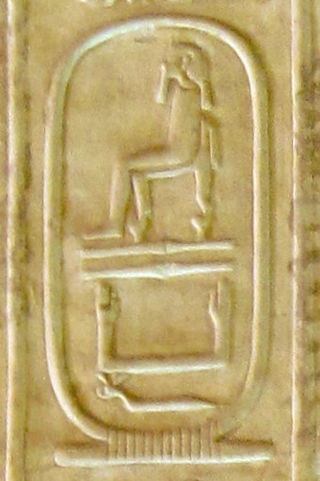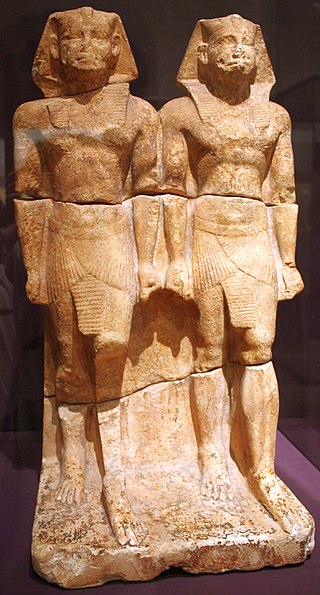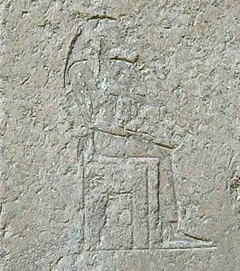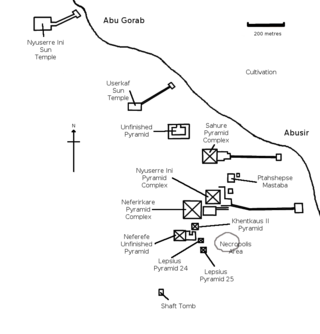
A mastaba, also mastabah or mastabat) is a type of ancient Egyptian tomb in the form of a flat-roofed, rectangular structure with inward sloping sides, constructed out of mudbricks or limestone. These edifices marked the burial sites of many eminent Egyptians during Egypt's Early Dynastic Period and Old Kingdom. Non-royal use of mastabas continued for over a thousand years.

Shepseskaf was a pharaoh of ancient Egypt, the sixth and probably last ruler of the fourth dynasty during the Old Kingdom period. He reigned most probably for four but possibly up to seven years in the late 26th to mid-25th century BC.

Neferirkare Kakai was an ancient Egyptian pharaoh, the third king of the Fifth Dynasty. Neferirkare, the eldest son of Sahure with his consort Meretnebty, was known as Ranefer A before he came to the throne. He acceded the day after his father's death and reigned for eight to eleven years, sometime in the early to mid-25th century BCE. He was himself very likely succeeded by his eldest son, born of his queen Khentkaus II, the prince Ranefer B who would take the throne as king Neferefre. Neferirkare fathered another pharaoh, Nyuserre Ini, who took the throne after Neferefre's short reign and the brief rule of the poorly known Shepseskare.

Menkauhor Kaiu was an Ancient Egyptian pharaoh of the Old Kingdom period. He was the seventh ruler of the Fifth Dynasty at the end of the 25th century BC or early in the 24th century BC.

Neferefre Isi was an ancient Egyptian pharaoh of the Fifth Dynasty during the Old Kingdom period. He was most likely the eldest son of pharaoh Neferirkare Kakai and queen Khentkaus II. He was known as prince Ranefer before he ascended to the throne.

Nyuserre Ini was an Ancient Egyptian pharaoh, the sixth ruler of the Fifth Dynasty during the Old Kingdom period. He is credited with a reign of 24 to 35 years depending on the scholar, and likely lived in the second half of the 25th century BCE. Nyuserre was the younger son of Neferirkare Kakai and queen Khentkaus II, and the brother of the short-lived king Neferefre. He may have succeeded his brother directly, as indicated by much later historical sources. Alternatively, Shepseskare may have reigned between the two as advocated by Miroslav Verner, albeit only for a few weeks or months at the most. The relation of Shepseskare with Neferefre and Nyuserre remains highly uncertain. Nyuserre was in turn succeeded by Menkauhor Kaiu, who could have been his nephew and a son of Neferefre.

Shepseskare or Shepseskara was an Ancient Egyptian pharaoh, the fourth or fifth ruler of the Fifth Dynasty during the Old Kingdom period. Shepseskare lived in the mid-25th century BC and was probably the owner of an unfinished pyramid in Abusir, which was abandoned after a few weeks of work in the earliest stages of its construction.

Abusir is the name given to an ancient Egyptian archaeological pyramid complex comprising the ruins of 4 kings' pyramids dating to the Old Kingdom period, and is part of the Pyramid Fields of the Memphis and its Necropolis UNESCO World Heritage Site.

Khentkaus II was a royal woman who lived in ancient Egypt. She was a wife of Egyptian king Neferirkare Kakai of the Fifth Dynasty. She was the mother of two kings, Neferefre and Nyuserre Ini.

The pyramid of Neferirkare was built for the Fifth Dynasty pharaoh Neferirkare Kakai in the 25th century BC. It was the tallest structure on the highest site at the necropolis of Abusir, found between Giza and Saqqara, and still towers over the necropolis. The pyramid is also significant because its excavation led to the discovery of the Abusir Papyri.

The pyramid of Sahure is a pyramid complex built in the late 26th to 25th century BC for the Egyptian pharaoh Sahure of the Fifth Dynasty. It introduced a period of pyramid building by Sahure's successors in Abusir, on a location earlier used by Userkaf for his sun temple. The site was first thoroughly excavated by Ludwig Borchardt between March 1907 and 1908, who wrote the standard work Das Grabdenkmal des Königs Sahu-Re between 1910 and 1913.

The pyramid of Neferefre, also known as the pyramid of Raneferef, is a 25th century BC unfinished pyramid complex built for the Egyptian pharaoh Neferefre of the Fifth Dynasty. Neferefre's unfinished pyramid is the third and final one built on the Abusir diagonal – a figurative line connecting the Abusir pyramids with Heliopolis – of the necropolis, sited south-west of Neferirkare's pyramid.

The pyramid of Djedkare Isesi is a late 25th to mid 24th century BC pyramid complex built for the Fifth Dynasty pharaoh Djedkare Isesi. The pyramid is referred to as Haram el-Shawaf by locals. It was the first pyramid to be built in South Saqqara.

Khentkaus I, also referred to as Khentkawes, was a royal woman who lived in ancient Egypt during both the Fourth Dynasty and the Fifth Dynasty. She may have been a daughter of king Menkaure, the wife of both king Shepseskaf and king Userkaf, the mother of king Sahure. Some suggest that she was the regent for one of her sons. Perhaps, in her own right, she may have been the king of Upper and Lower Egypt, which aspects of her burial suggest. Her mastaba at Giza – tomb LG100 – is located very close to Menkaure's pyramid complex. This close connection may point to a family relationship. Although the relationship is not clear, the proximity of the pyramid complex of Khentkaus to that of king Menkaure has led to the conjecture that she may have been his daughter.
Reptynub was a queen during the Fifth Dynasty of Egypt. She was the wife of King Nyuserre Ini. She was possibly a mother of Menkauhor Kaiu.

The Double Pyramid, also known as Lepsius XXV, designates a pair of adjacent monuments located on the south-eastern edge of the Abusir necropolis, south of the pyramid Lepsius XXIV and of the pyramid of Khentkaus II. The pair of monuments was built during the mid-Fifth Dynasty, likely during Nyuserre Ini's reign, for two female members of the extended royal family.

The Lepsius XXIV Pyramid is an Egyptian pyramid, which was probably built for a wife of King Nyuserre Ini. The largely destroyed 5th Dynasty structure is located in the pyramid field of Abusir, east of the Pyramid of Neferefre and south of the Pyramid of Khentkaus II.

The pyramid of Khentkaus II is a queen's pyramid in the necropolis of Abusir in Egypt, which was built during the Fifth dynasty of Ancient Egypt. It is attributed to the queen Khentkaus II, who may have ruled Egypt as a reigning queen after the death of her husband Neferirkare Kakai. The pyramid is now a heavily damaged ruin, which only stands 4 metres high.

The pyramid of Nyuserre is a mid-25th-century BC pyramid complex built for the Egyptian pharaoh Nyuserre Ini of the Fifth Dynasty. During his reign, Nyuserre had the unfinished monuments of his father, Neferirkare Kakai, mother, Khentkaus II, and brother, Neferefre, completed, before commencing work on his personal pyramid complex. He chose a site in the Abusir necropolis between the complexes of Neferirkare and Sahure, which, restrictive in area and terrain, economized the costs of labour and material. Nyuserre was the last king to be entombed in the necropolis; his successors chose to be buried elsewhere. His monument encompasses a main pyramid, a mortuary temple, a valley temple on Abusir Lake, a causeway originally intended for Neferirkare's monument, and a cult pyramid.

The pyramid of Khentkaus I or step tomb of Khentkaus I is a Fourth Dynasty two-stepped tomb built for the Queen Mother Khentkaus I in Giza. The tomb, built in two phases coinciding with its two steps, was originally known as the fourth pyramid of Giza. In the first phase, a nearly square block of bedrock, around which the stone had been quarried for the Giza pyramids, was utilised to construct her tomb and encased with fine white Tura limestone. In the second phase, most likely in the Fifth Dynasty, her tomb was enlarged with a large limestone structure built on top of the bedrock block. The Egyptologist Miroslav Verner suggests that this may have been intended to convert her tomb into a pyramid, but was abandoned as a result of stability concerns. South-west of the tomb was a long boat pit, which housed the Night boat of Re. A companion day boat has not been found. A chapel was built into the tomb superstructure, with a large granite entrance bearing the queen's name and titles. One of her titles was of particular interest because it had not been known of prior to its discovery at her tomb.


















